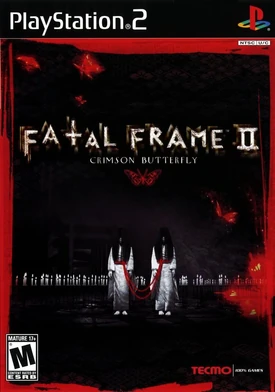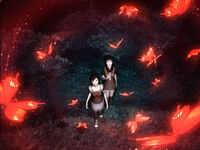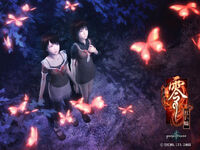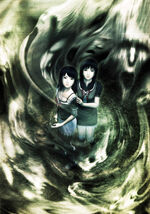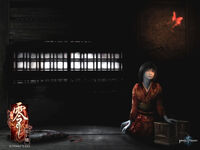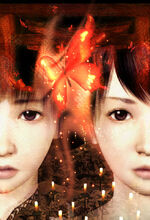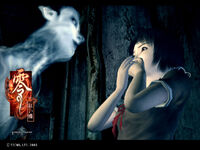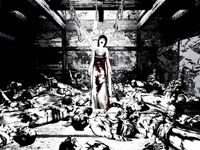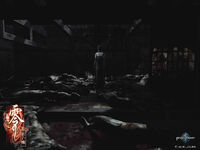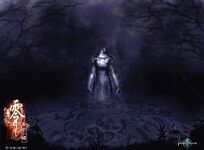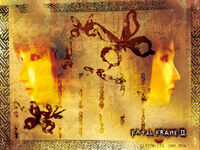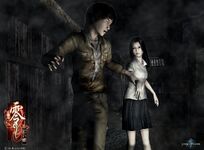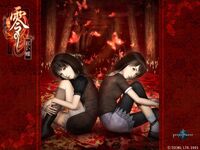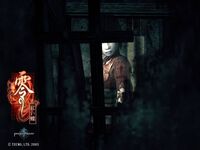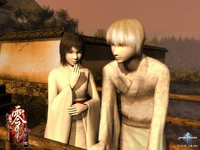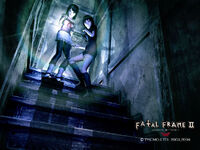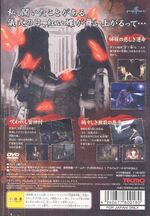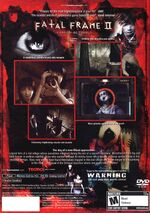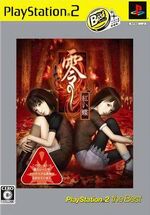| This article is for the PlayStation 2 release of the game. For the subsequent Xbox release, see Fatal Frame II: Crimson Butterfly Director's Cut. |
| Fatal Frame II: Crimson Butterfly | |||
|---|---|---|---|
| 零 ~紅い蝶~ Zero ~Akai Chou~ Project Zero II: Crimson Butterfly | |||
| Developer(s) | Tecmo, Ltd. | ||
| Publisher(s) | Tecmo, Ltd. (Jap.) Tecmo, Inc. (US) Ubisoft Entertainment SA (Germany, France, UK, Australia, Finland) Sony Computer Entertainment America, Inc. (PSN release, US) | ||
| Release date(s) | November 27, 2003 (Jap.) December 10, 2003 (US) April 28, 2004 (Germany) April 29, 2004 (France) April 30, 2004 (UK) June 30, 2004 (Australia) August 05, 2004 (PlayStation 2 the Best release, Jap.) February 12, 2005 (Finland) November 22, 2007 (PlayStation 2 the Best reprint, Jap.) May 07, 2013 (PSN release, US) | ||
| Ratings | Mature (17+) (ESRB) CERO C (15+) (Jap.) 16+ (PEGI) | ||
| Platform | PlayStation 2 | ||
| “ | "Didn't we promise each other... that we would always be together... | ” |
—Sae Kurosawa | ||
Fatal Frame II: Crimson Butterfly, known in Japan as Zero ~Akai Chou~ (Zero ~Crimson Butterfly~) and in Europe as Project Zero II: Crimson Butterfly, is a Japanese survival horror game and the second installment in the Fatal Frame series.
The PlayStation 2 port was developed and published by Tecmo on November 27, 2003 in Japan and December 10, 2003 in North America, and was published by Ubisoft on April 30, 2004 in Europe. It was re-released as a "PlayStation 2 Classic" on the PlayStation Network for the PlayStation 3 on May 7, 2013 in North America. The game also had a Director's Cut version released for the Xbox in 2004 and a remake entitled Fatal Frame II: Deep Crimson Butterfly released for the Nintendo Wii in 2012.
The game resumes the characteristic use of a camera to fend off ghosts, only this time without the claim of being "Based on a true story". Despite this, Fatal Frame II is arguably the most known of the Fatal Frame series, due to its engaging story, refined use of the camera and abundant scares.
Synopsis
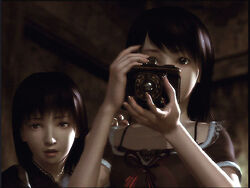
Mio using the Camera Obscura for the first time.
The twin sisters, Mio and Mayu Amakura, are visiting a childhood play spot when Mayu, who walks with a limp after a childhood accident, follows a mysterious crimson butterfly deep into the woods. Mio, concerned for her sister, follows Mayu, and the two girls are led to a lost village. The village is curiously empty, and it is revealed to have been cursed by some past event, trapping the village in perpetual night.
As the Amakura twins investigate, they discover the Camera Obscura and are set upon by the ghosts of the past villagers. Mayu is eventually led astray by the ghosts and Mio becomes determined to save Mayu and escape before they meet the same cursed fate as the village's former residents. However, Mio learns that in order to save her sister and escape the village, she must delve deeper into a ritual that was performed in the village: the Crimson Sacrifice Ritual, where one twin must kill the other.
Plot
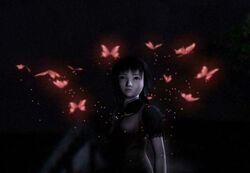
Mayu is lead to the lost village by crimson butterflies.
- For more details see: Fatal Frame II Chapters.
Mio and Mayu visit a spot in the forest that they used to play at during their childhood. The area is soon to be a dam site and the two sisters reminisce about the times they spent there. While remembering an accident in the forest that left Mayu's leg weak, Mio notices that her sister has disappeared. She sees Mayu chasing a crimson butterfly and, after following her, the two are spirited away into All God's Village (a.k.a. "The Lost Village" and "Minakami Village".)
Unknown to the twins, the village is the site of a mysterious ritual that failed, causing the village to be trapped in continuous night and to disappear from the region, destined to relive the events of the ritual's failure forever. The two sisters discover a newspaper clipping and photo of a couple on the outskirts of the village and decide to investigate before leaving by entering one of the nearby family houses after seeing a female ghost entering it. Inside they find the abandoned Camera Obscura, as well as the diaries of a woman who came to the village in search of her missing boyfriend, which the twins assume to be the ghost they viewed previously. Upon finding her final diary, the woman's ghost attacks the sisters in anger, forcing Mio to use the camera to exorcise her.
After defeating the female ghost, Mio passes out and learns in a vision that the ghost, Miyako Sudo, was trapped in the village and then strangled by her boyfriend's ghost, seemingly an act of madness after he was also trapped in The Lost Village. During this vision, brief scenes of a woman in a white kimono is shown, laughing maniacally, an event that is also described in Miyako's diaries and is implied to have been an influence in her mental disintegration before being found by her boyfriend and killed. Mio wakes up from the vision alone and sees her sister about to leave the house by herself, apologizing and saying that she must go. Mayu is then shown following a trail of crimson butterflies deeper into the village, stopping in an alleyway where an unknown woman in a white kimono is standing, facing away from her. Mio traces Mayu's path and is led towards the house of the village's ceremony master, the Kurosawa House. She views Mayu entering through the front gate, but cannot reach her in time, and discovers that the gate to the house is now locked, forcing her to go find the keys. When leaving the gate, Mio is also greeted by the crimson butterflies, which lead her to a storehouse where she meets an unnamed white-haired boy (Itsuki), who is locked inside the storehouse for unknown reasons. Itsuki says to Mio, whom he refers to as "Yae", that "the ritual is about to start" and the she and Sae must leave the village immediately. He tells Mio that "Sae is about to start the ritual at the ceremony master's house," and tells her how to find the gate keys so she can go stop her. At this time, it is unknown to Mio why she is being called Yae, but there is no doubt that Itsuki's reference to Sae overlaps with Mio's twin, Mayu, who is also at the ceremony master's house, implying that Yae and Sae are also twins. Before departing, Itsuki tells Mio that if she cannot find a way to leave the village, to come back to him for assistance. Mio is now free to explore the village to search for the gate keys, which opens a new area at the back of the village where veiled priests are seen traveling up a path to a shrine housing an old mirror, along with an area atop a hill with an alter and torches being guarded by a group of angry villager ghosts. After retrieving the gate keys from their respective shrines, Mio makes her way to the ceremony master's house.
Inside the Kurosawa house, Mio encounters more ghosts of the villagers and veiled priests who speak, saying things like "the twins that become the sacrifice have returned" and "The Kusabi is coming", though the Kusabi is not explained at the time. A scene then shows Mayu walking in a trance-like state through the house, murmuring "The Repentance has begun. Everyone is dead," before entering a room where the unknown woman in the white, now bloody, kimono (Sae) is standing. After Mio also makes her way to that room, she receives a vision where the room is covered in dead bodies and Sae is standing in the middle, laughing maniacally, before an entity of a tormented man covered with ropes appears and begins to chase her. Unknown to Mio at the time, this ghost is called the Kusabi and it pursued and murdered many of the village's inhabitants during the Repentance, the disastrous result of the failed Crimson Sacrifice. Mio finally escapes the Kusabi and continues to look for her sister. In the house, she finds research from The Folklorist, Seijiro Makabe, which describes the Crimson Sacrifice ritual's purpose to seal the gate to hell and how it results in Twin Shrine Maidens becoming crimson butterflies that return to watch over the village. His research also finally reveals to the player that the Repentance is a reference to the disaster that occurs whenever all of the multiple attempted ceremonies that make up the Crimson Sacrifice ritual end up failing, a time when the gate to hell will open and release calamity, plunging the village into darkness. Later, a vision shows the Folklorist, along with his assistant, Ryozo Munakata, arriving at All God's Village in order to conduct this research and is interrupted multiple times with images showing the Folklorist being tied up in ropes, thus turning him into the Kusabi, though this process and connection is still not explained to the player. The Folklorist's research additionally reveals that Munakata is looking for his friends, the twin boys Itsuki and Mutsuki, in the village, but they are nowhere to be found.
Mio finally reunites with Mayu, though she is beginning to show signs of possession, such as moving erratically and sometimes speaking as if she were someone else. Mayu claims that somebody was calling her to the house to perform the ritual again, but does not specify who. The girls now begin to collect butterfly diaries, which contain entries from both Yae and Sae, and finally begin to open up the backstory of their shrine experience, along with the events invlolving the aforementioned Kusabi. The first entry describes how the Folklorist is likely to be turned into the Kusabi (though that term is purposefully removed from the page) because they aren't ready for the ritual yet and they want to help him escape the village before that happens. Unable to escape through the house's front opening, the sisters try to pass through the basement. However, Mayu gets locked inside a prison cell while retrieving a key. The cell is held closed by a lock and the key for the lock is not nearby, so again the two must separate and Mayu has to wait for her sister to find the key. After leaving her sister behind, Mio is directed towards the Osaka house, where a family altar hides a passage to an underground storage cave. Mio searches for the key inside the cave, but mistakenly alerts the ghosts that haunt the village's underground. One of the ghosts drops the key that unlocks Mayu's cell and, after picking it up, Mio can either defeat the ghosts or avoid them. Key in hand, Mio returns to her sister's side. Upon Mio's return to the cell, however, she finds that Mayu has yet again disappeared. It is revealed that Mayu has entered the Kiryu House, another large house in the village, and is making her way to the Tachibana House through a bridge connecting the two houses. As the door to the Tachibana house is locked, Mio makes her way through the Kiryu house to retrieve her sister.
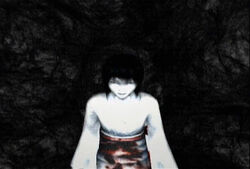
The ghost in the bloody kimono, pursuing Mio
While searching through the Kiryu house, Mio learns more about the Crimson Sacrifice Ritual, which involves one twin killing the other in order to protect the village from harm. The twin that is left after the ritual is referred to as the Remaining, and the Remainings suffer from so much grief that their hair turns white. Some time ago, twins born to the Kiryu house, Akane and Azami Kiryu, also underwent the Crimson Sacrifice Ritual.
Eventually, Mio finds out that the bridge Mayu just crossed has somehow become locked, though there is another way, an underground tunnel, that Mio can use to enter the adjacent house. On her way through the tunnel, however, Mio is stalked by the ghost of the last Crimson Sacrifice Ritual, a woman in a bloody white kimono. While running from the ghost, Mio drops the Camera Obscura and has no choice but to exit the tunnel without it. Inside the Tachibana house, Mio is still being chased by the malicious spirit, but without the Camera Obscura to defend herself, Mio has no choice but to flee from the ghost, go back to the tunnel, and retrieve the camera. The tunnel is only one-way, so Mio must navigate through the Tachibana house and use the connecting bridge to return to the Kiryu house and re-enter the tunnel from there.
The ghost follows Mio as she goes through the house, laughing and asking Mio if she is leaving her again. At some point, she also imitates Mayu's voice in an effort to trick Mio. Mio is able to avoid the ghost, return to the tunnel, and retrieve the camera. Moments later, upon entering the Tachibana house, she finds that the ghost with the bloody kimono is no longer in pursuit and she is able to resume her search for Mayu. While freely exploring the Tachibana house, Mio uncovers more of the village's history. It turns out that Itsuki also had a twin brother, Mutsuki Tachibana, and they had also performed the Crimson Sacrifice. Their ritual failed, however, and the villagers became desperate to prevent the Repentance from occurring.
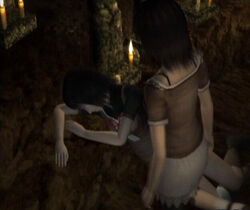
Mayu rests in the Old Tree
Mio is able to find Mayu, who seems to have regained her composure, and the two decide it's time to escape the village. They plan to use an escape tunnel beneath the village's shrine, which was sealed off after a set of twins in the past used it and were caved in. Mio knows how to unseal the entrance to the tunnel, however, and she heads to the Old Tree, where the mechanism to open the way is located. In order to open the tunnel, Mio needs to gather the four crests that are held by each household of the village. Mio has already picked up the Tachibana crest while inside the Tachibana house, and so she must collect the remaining three crests in the other locations. However, Mayu is tired and must rest while her sister gathers the crests. While unconscious, Mayu repeats phrases related to the three locations of the remaining crests:
- "Deep in the cemetery...an altar...at the Tsuchihara grave, "
- "The bridge that connects the two houses...a doll...a secret room in the wall..."
- "A woman...hiding in a kimono box..."
As Mio places her hand on Mayu's shoulder, she is swept into a vision that Mayu's sixth sense reveals. In the vision, Mio is walking down a path leading to the Hellish Abyss deep below the village. It is there that the Crimson Sacrifice takes place and, upon arriving at the abyss, she is shown that her sister has already fallen within. Determined to save her sister, Mio finds the other three crests, but before returning, she heads to the storehouse to see Itsuki one last time. When she arrives, she learns that Itsuki was imprisoned in the storehouse for helping Yae and Sae escape. The escape failed, however, and only Yae was able to leave the village. Sae was brought back to fulfill the ritual alone and Itsuki was locked in the storehouse. Unable to bear the grief of failing his brother and friends, Itsuki took his own life by hanging himself inside the cell. Like Mio, Sae went to the storehouse to see him one final time, but she arrived too late. Mio returns to the old tree and unseals the tunnel out of the village. While on their way to the tunnel, however, Mayu is captured by the ghosts of the villagers, who want to use her to complete the ritual yet again. Mio makes her way to the Kurosawa house, where the way to the abyss is found. Upon reaching the abyss, Mio is shown what occurred on the day the village was swallowed in darkness.
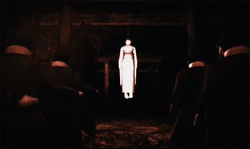
Sae is sacrificed alone for the ritual.
Since only Yae had escaped the village, the people panicked, not knowing if they should continue with the ritual. Sae waited for her sister to return, believing in the promise they made to always be together. In the end, the villagers decided that the ritual must go on or else the malice spilling out of the abyss will be too much. Sae was taken to the abyss alone and was hanged before being thrown in. Because the ritual was meant for one twin to kill the other, Sae's sacrifice failed, and her corrupted spirit returned from the abyss, bringing the darkness that engulfed the entire village. Along with Sae, the ghost of the Kusabi, an earlier sacrifice, returned and the two spirits unleashed their vengeance on the villagers in what was known as the Repentance.
Sae and the Kusabi slaughtered the people of the village, while Sae's laughter filled the air. Sae vowed to wait forever for her sister, however, and when Mio and Mayu arrived, the villagers' spirits saw their chance to repeat the ritual to free themselves. Sae possessed Mayu, determined to repeat her sacrifice, but this time Mio would be there to be by her sister's side. Depending on the game's difficulty and the player's choice, Mio must defeat the ghost of the Kusabi or Sae herself and, once doing so, frees herself and the village from the curse of the Crimson Sacrifice Ritual.
Endings
- For more details see: Fatal Frame II Endings
There are four potential endings for the game. Two can be obtained by completing the game on varying difficulties, while one is exclusive to the Director's Cut version of the game for the Xbox.

Fatal Frame 2 Normal Ending
Mio and Mayu complete the failed Crimson Sacrifice Ritual.
Crimson Butterfly ending
Finding Mayu in time, Mio looks to see the ghosts lining up in a circle as she goes to tug at Mayu. Mayu says to her sister that there is no other way out but to finish the ritual, and Mio has no choice but to take her sister's life. Mio's hands are placed on Mayu's neck and soon enough Mayu is dead. The ghosts pick Mayu up, throwing her into the Hellish Abyss, completing the ritual. A single crimson butterfly soars up, and Mio chases after it in tears. She says how sorry she is before finally seeing Mayu is leading her to the gate. It is then seen swarms of the butterflies, all from the past rituals before the final scene shows. Moments later, Mio is shown sitting on a bench near the newly formed lake, her neck showing a crimson mark of what looks like a single butterfly, symbolizing the twins becoming one.
According to the events in Fatal Frame III: The Tormented, this is considered the canon ending.
Hellish Abyss ending
Running to save her sister, Mio finds Mayu possessed and about to jump, but Mio takes her hand saves her at the last moment. In doing so, the ghost of Sae is expelled from Mayu's body and falls into the Hellish Abyss. However, while pulling her sister up, Mio accidentally gazes into the abyss. The sight of the souls inside the abyss rushes into Mio's eyes and permanently blinds her. Mayu then recounts how the two escaped the village and were found unconscious in the woods. She also states that the village exists no more. The camera reveals the two sitting on a bench overlooking the new lake, Mio's eyes covered with bandages. Mayu then says that it's her turn to take care of Mio now.
Runaway ending
Mio realizes she cannot keep her promise to Mayu and runs away alone through the tunnel beneath Kureha Shrine. While running, she hears Sae's voice asking "Are you leaving me again?". She hesitates, hearing Itsuki's voice tell her not to look back. She turns around after hearing Mayu's voice call out, only to see a menacing Sae moving towards her. Mio freezes in shock and fear as Sae approaches her and everything goes black. A moment later, Mio wakes up by a river, alone. Worried, she calls out to Mayu repeatedly, but receives no answer. Both Sae and Mayu now wait forever for their sisters.
This ending is achieved by exiting underneath Kureha shrine instead of going to the Kurosawa house to save Mayu. This scene is much less of an ending than the others, resulting in a Game Over screen, rather than the finishing credits. The ending is given the name "Lingering Scent" in the Gallery of the Xbox Director's Cut version.
Promise ending
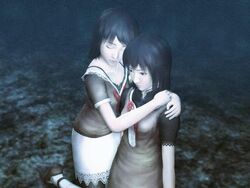
Mayu is saved
Mio is running down a tunnel to get to the sacrificial site. When she sees Mayu heading towards the abyss in a trance, she calls out her name and runs to her. The priests banging their staffs vanish and, as Mio runs, Yae's spirit appears out of her. Yae walks toward Mayu, who takes the form of Sae as she turns around to face her twin. Yae apologizes for leaving her sister alone and Sae forgives her. The twins join hands and walk towards the pit, promising to be together for eternity. Realizing that they both intend to jump, Mio runs towards to Sae, who is using Mayu as a host. She wraps her arms around Sae's waist and pulls Mayu out of her just before Yae and Sae jump into the abyss. With the successful completion of the ritual, the crimson butterflies fly from the pit and go off into the sky. The souls of the villagers and victims of the Repentance are seen throughout the village, watching the butterflies. Mio and Mayu leave the village, hand in hand. Mayu confesses that she was overwhelmed by the fact that they would live and die separately. Mio tells her that, even though that will happen, she'll never let Mayu go again. The sun rises and the game ends on a happy note.
Deep Crimson Butterfly (Wii Edition) Endings
These endings aren't canon, but serve as addition for this version of the game.
Shadow Festival Ending
Mio encounters the Kusabi one last time, but it takes some time for her to defeat it (more than 5 minutes), and as a result causes the events from All God's Village to repeat itself. Seemingly tired from the Kusabi fight, Mio stumbles in an attempt to move forward. After a few steps she stops at the first shrine before the stairs and sees the ghosts of the people that were performing the ritual fleeing upstairs, screaming that The Repentance was coming.
Immediately becoming worried, she quickly tries to get to where Mayu is, only to see her kneeling close to the Abyss. Mayu, possessed by Sae, starts talking to Mio, who now sees her as Yae, saying that The Repentance was coming towards the surface. Though she was happy to see that Mio/Yae returned for her, she was still sad that it was too late, and that she would have preferred for Mio/Yae to have abandoned her so that they were "at least saved".
Meanwhile, The Repentance starts to pour out from the Abyss, about to shroud the village in darkness. Mio, surrendering, kneels close to Mayu and admits that it would be hard to live without her, with all "the sadness and pain" she would have to endure, but that she was happy to be with her, even if it was for "such a short time".
The scene quickly switches to a flashback from both Mio and Mayu's childhood, where they are both wearing kimonos with different colors and patterns, seemingly enjoying a Red Lantern festival. Both appear to be very happy to be with each other, and proceed to let go of their lanterns where they float up towards the sky together. After that the scene changes to the present, where a still imprisoned Itsuki, after encountering a crimson butterfly, suddenly looks out the window to see The Repentance coming towards the village. Not long after the entire village becomes shrouded in an inky darkness, repeating the events of the village's tragic past.
After that, both Mio and Mayu are seen shrouded by a deep darkness, apparently nude, but covered by a golden cloth and cuddled against each other. It is interesting to note that they are both positioned just like the twins shown in the Twin Maiden stones in not only the game, but also the ones in real life
Frozen Butterfly Ending
After exorcising Sae from Mayu's body, Mayu pulls Mio's hands close, encircling them around her neck with the intent of becoming one but Mio pulls away, refusing. Mayu tells her she always knew her sister could never do such a thing and how she loves her because of that. She tells her that, as long as they are together, she doesn't care if she has to live in hell and starts laughing and crying at the same time.
A flashback is shown in which Mayu had temporarily snapped under the pain and stress of going through a near death experience, laughing and crying simultaneously. It can be interpreted that Mayu had always been mentally unstable since that moment or that Sae had been in possession of her since their childhood.
Mayu asks her sister to stay in the village with her forever as she encloses her hands around Mio's neck.
A crimson butterfly flutters it's way across a room full of dead and marred bodies to land on the sleeve of an inert Mio whose head is being stroked by Mayu in her lap. With the roles for the having been ritual reversed, Mayu and her sister's body remain trapped in the village for eternity.
At the end of the credits, Mayu is shown in the doll room, making up Mio's lips. She looks at her sister and kisses her on the cheek, as Mio seems to be crying, then holds her head.
Gameplay

Viewfinder mode in Fatal Frame II.
Fatal Frame II uses gameplay mechanics very similar to its predecessor, with some changes and updates. For most of the game the player controls Mio Amakura, except for some short scenes where they control her elder twin sister Mayu. Mio's only weapon is the Camera Obscura, an antique camera with the ability to take pictures of ghosts and exorcise them. Like in the previous game, special film types and lenses can be found that increase the damage it can deal. The camera's native functions and the special lenses can be upgraded using Spirit Orbs found in the game and points earned from photographing ghosts.

Mio and Mayu exploring the village
The camera also features a unique filament which glows red when facing a hostile ghost or blue when there is a non-hostile ghost nearby.
During the game, Mio has to explore the entire village area and its central buildings, and needs to find various objects and solve puzzles in order to advance. In addition to hostile ghosts, there are numerous vanishing and hidden spirits Mio can photograph to receive clues or reveal the story of the village. The game is divided into chapters, mostly related to certain areas which Mio visits as she chases after her sister. The total number of chapters is nine, with a special tenth chapter available in hard and nightmare difficulty settings.
The game has a new game plus feature, where the player can start a new game while keeping their camera with all the special functions, lenses and upgrades from the previous playthrough, as well as all the stored health supports and film. Over multiple playthroughs the player can unlock various bonus content, including a mission mode, different outfits, gallery features and special lenses for the camera. In mission mode, the player is presented with a challenge, usually to kill certain ghosts as quickly as possible or getting the highest points possible.
Director's Cut Gameplay
The director's cut edition for Xbox also has an FPS mode, where the player can play through the entire game in first person. This does a lot in fixing the problems inherent with fixed camera locations. Unfortunately, the FPS mode also takes away some of the game's atmosphere. The Xbox version also includes a survival mode, a new ending, enhanced graphics, a greater number of alternate costumes to unlock and a shop, where the player can trade points from pictures for items.
Reception
The game's aesthetic presentation was highly praised by critics and fans alike. As the name would suggest, the dominant color for the game was a brilliant red, creating a bold and striking contrast to much of the game's shadowed and nocturnal settings. The title was ranked #2 in Gametrailers' "Top Ten Scariest Games" in 2006, and #3 in X-Play's "Top Ten Scariest Games of All Time". Game Informer ranked it number one on a similar list.
Translation Differences
While the English translation of the game is generally of high quality, one important thing could not be carried over from the original Japanese. In Japanese, Mio calls Mayu "Onee-chan", meaning literally "big sister", clearly indicating the order of the twins. While this is perfectly normal in Japanese, it would sound odd in English, and therefore Mio calls Mayu by her name instead. Because of this, there isn't anything in the English translation that would tell the player which of the twins is the elder, while in Japanese it was clear that Mio was the younger and therefore destined to be sacrificed - until the revelation near the end that in the village's tradition the twin order is reversed, and Mio's fate is to sacrifice her sister instead. This revelation is largely lost in the translation.
Interview with the developers
An interview with Makoto Shibata (director) and Keisuke Kikuchi (producer), was published as below:
Sales in Japan
Fatal Frame II was released on November 27.
Below is displayed the weekly results based on Famitsu's software sales chart:
Famitsu's Top 30
Week ??, 2003 (November 24 - November 30)
The game debuted at 9th place, selling 42.006 units, but didn't become the highest sold PS2 title of the week for staying behind the PS2 games: Hot Shots Golf 4 (1st place), Wild ARMs: Alter Code F (3rd place), Castlevania (5th place), R: Racing Evolution (7th place) and Kamen Rider justice lineage (8th place). [1]
Week ??, 2003 (December 1 - December 7)
The game declined 15 positions in the ranking, jumping from 9th to 24th place, selling 8.932 units.
The number of sales combined with the previous week resulted in a total of 50.938 units sold. [2]
Week ??, 2003 (December 8 - December 14)
The game didn't reach the Top 30. [3]
Global sales
Below is displayed the number of units sold worldwide according to VGChartz:
North America: 0.08m (49.0%)
Europe: 0.06m (38.2%)
Rest of the World: 0.02m (12.8%)
Global: 0.16m
As of February 21st 2015, 0.16m units were sold. [4]
Trivia
- The game's ending theme is Chou, performed by Tsukiko Amano.
- If the game is left idle for about five minutes, the face of a limbo woman ghost will appear sporadically on the screen, like a screen saver.
- The game is now discontinued.
- This game reveals the name of one of the twins and the name of the folklorist that was friends with the white-haired boy, Itsuki Tachibana. In the first game you then realize that Yae is Miku Hinasaki's great-grandmother who committed suicide after the disappearance of her daughter while playing demon tag with other children from a nearby village. Miku's mother also committed suicide, and that is revealed in the first game.
Promotional images
|
Promotional image featuring Chitose Tachibana. Promotional art featuring Sunken Woman. |

